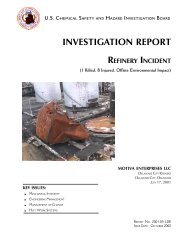CTA Report, Draft 1, ISP Review - US Chemical Safety and Hazard ...
CTA Report, Draft 1, ISP Review - US Chemical Safety and Hazard ...
CTA Report, Draft 1, ISP Review - US Chemical Safety and Hazard ...
Create successful ePaper yourself
Turn your PDF publications into a flip-book with our unique Google optimized e-Paper software.
Flammability<br />
No. Stability Criteria<br />
4<br />
Severe<br />
3<br />
Serious<br />
2<br />
Moderate<br />
1<br />
Slight hazard<br />
0<br />
Minimal<br />
Table E-1<br />
HMIS Defined Degrees of Flammability <strong>Hazard</strong><br />
Materials that rapidly or<br />
completely vaporize at<br />
atmospheric pressure <strong>and</strong><br />
normal ambient temperature,<br />
or that are readily dispersed<br />
in air <strong>and</strong> readily burn<br />
Liquids <strong>and</strong> solids that can be<br />
ignited under almost all<br />
ambient temperature<br />
conditions; materials that<br />
produce hazardous<br />
atmospheres with air under<br />
almost all ambient<br />
temperatures—or, unaffected<br />
by ambient temperatures, are<br />
readily ignited under almost<br />
all conditions<br />
Materials that must be<br />
moderately heated or<br />
exposed to relatively high<br />
ambient temperatures before<br />
ignition; materials that would<br />
not under normal conditions<br />
form hazardous atmospheres<br />
with air, but under high<br />
ambient temperatures or<br />
moderate heating may<br />
release sufficient quantities of<br />
vapor to produce hazardous<br />
atmospheres with air<br />
Materials that must be<br />
preheated before ignition;<br />
materials that require<br />
considerable preheating for<br />
ignition or combustion under<br />
all ambient temperature<br />
conditions<br />
Typically Includes<br />
Flammable gases<br />
Flammable cryogenic materials<br />
Any liquid or gaseous material that is liquid while<br />
under pressure <strong>and</strong> has a flash point below 73°F <strong>and</strong><br />
a boiling point below 100°F (NFPA Class IA)<br />
Materials that ignite spontaneously in air<br />
Liquids with a flash point below 73°F <strong>and</strong> a boiling<br />
point at or above 100°F (NFPA Class IB); also liquids<br />
with a flash point at or above 73°F <strong>and</strong> a boiling point<br />
below 100°F<br />
Materials that—because of physical form or<br />
environmental conditions—can form explosive<br />
mixtures with air <strong>and</strong> are readily dispersed in air, such<br />
as dusts of combustible solids <strong>and</strong> mists of flammable<br />
or combustible liquid droplets<br />
Materials that burn with extreme rapidity, usually by<br />
reason of self-contained oxygen (e.g., dry<br />
nitrocellulose <strong>and</strong> many organic peroxides)<br />
Liquids with a flash point at or above 100°F but not<br />
exceeding 200°F (i.e., NFPA Classes II <strong>and</strong> IIIA)<br />
Solid materials in the form of coarse dusts that may<br />
burn rapidly but generally do not form explosive<br />
atmospheres<br />
Solid materials in a fibrous or shredded form that may<br />
burn rapidly <strong>and</strong> create flash fire hazards, such as<br />
cotton, sisal, <strong>and</strong> hemp<br />
Solids <strong>and</strong> semisolids that readily give off flammable<br />
vapors<br />
Materials that burn in air when exposed to a<br />
temperature of 1,500°F for 5 minutes or less<br />
Liquids, solids, <strong>and</strong> semisolids with a flash point<br />
above 200°F (NFPA Class IIIB)<br />
Most ordinary combustible materials<br />
Materials that do not burn Any material that does not burn in air when exposed<br />
to a temperature of 1,500°F for 5 minutes<br />
122









